Associations Between Job Insecurity and Well-being: Belgium Banking
VerifiedAdded on 2020/11/12
|10
|2395
|253
Report
AI Summary
This report analyzes the associations between quantitative and qualitative job insecurity and the well-being of employees in the banking sector of Belgium. It details the sample size of 15,000 employees (representing 21% of the total workforce) and justifies its adequacy, emphasizing the practicality of sampling in large populations. The report explains the use of simple random sampling, outlining its advantages (simplicity, time-saving, and cost-effectiveness) and disadvantages (potential for errors, unsuitability for heterogeneous populations). It discusses the reliability and validity of the measures used, including test-retest, internal consistency, and inter-rater reliability, as well as face, content, criterion, and discriminant validity. The purpose of collecting social demographic data is also clarified, highlighting the use of control variables to test the reliability of the research. Finally, the report describes the descriptive research design employed, detailing its strengths (ability to gather in-depth information) and weaknesses (inability to establish correlations and potential for bias).
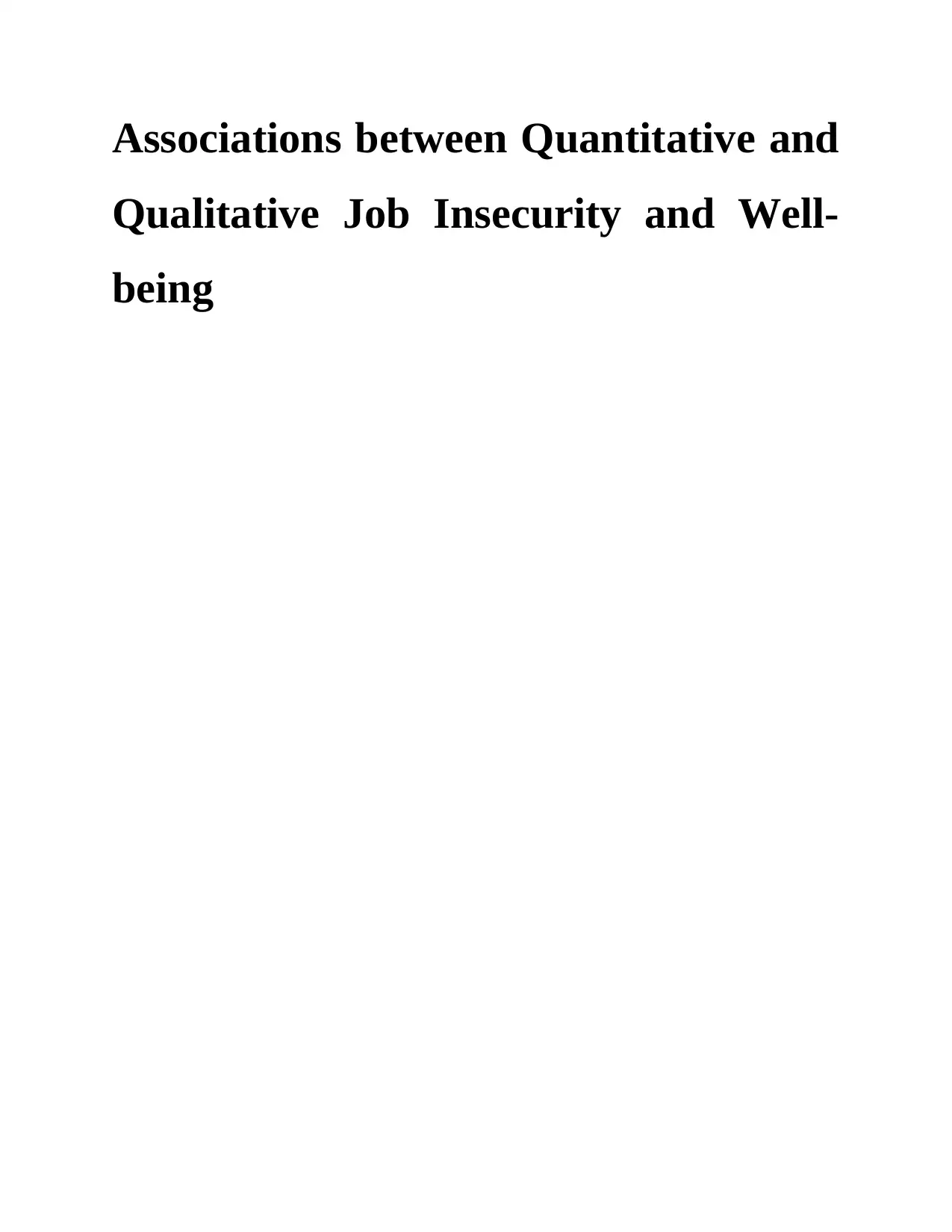
Associations between Quantitative and
Qualitative Job Insecurity and Well-
being
Qualitative Job Insecurity and Well-
being
Paraphrase This Document
Need a fresh take? Get an instant paraphrase of this document with our AI Paraphraser
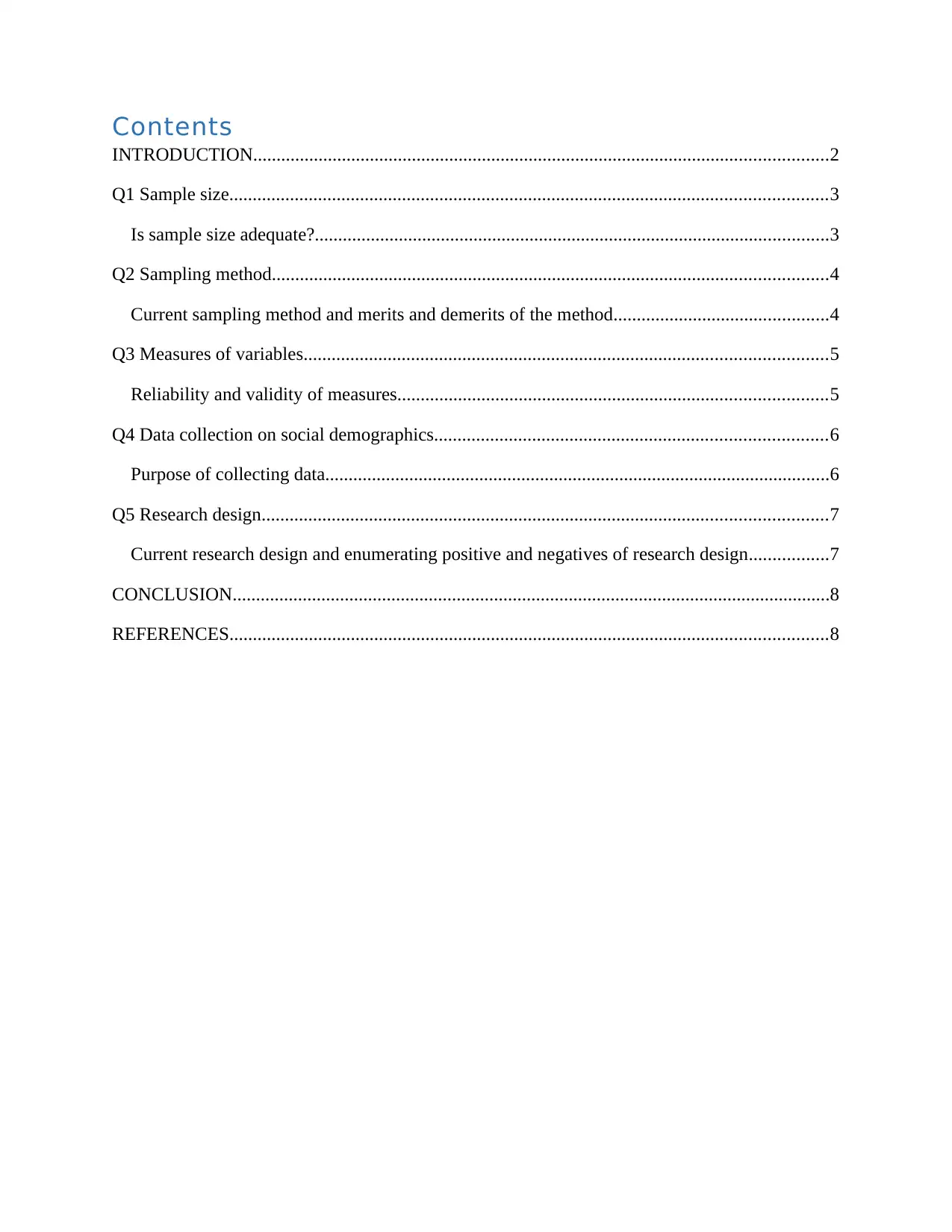
Contents
INTRODUCTION...........................................................................................................................2
Q1 Sample size................................................................................................................................3
Is sample size adequate?..............................................................................................................3
Q2 Sampling method.......................................................................................................................4
Current sampling method and merits and demerits of the method..............................................4
Q3 Measures of variables................................................................................................................5
Reliability and validity of measures............................................................................................5
Q4 Data collection on social demographics....................................................................................6
Purpose of collecting data............................................................................................................6
Q5 Research design.........................................................................................................................7
Current research design and enumerating positive and negatives of research design.................7
CONCLUSION................................................................................................................................8
REFERENCES................................................................................................................................8
INTRODUCTION...........................................................................................................................2
Q1 Sample size................................................................................................................................3
Is sample size adequate?..............................................................................................................3
Q2 Sampling method.......................................................................................................................4
Current sampling method and merits and demerits of the method..............................................4
Q3 Measures of variables................................................................................................................5
Reliability and validity of measures............................................................................................5
Q4 Data collection on social demographics....................................................................................6
Purpose of collecting data............................................................................................................6
Q5 Research design.........................................................................................................................7
Current research design and enumerating positive and negatives of research design.................7
CONCLUSION................................................................................................................................8
REFERENCES................................................................................................................................8
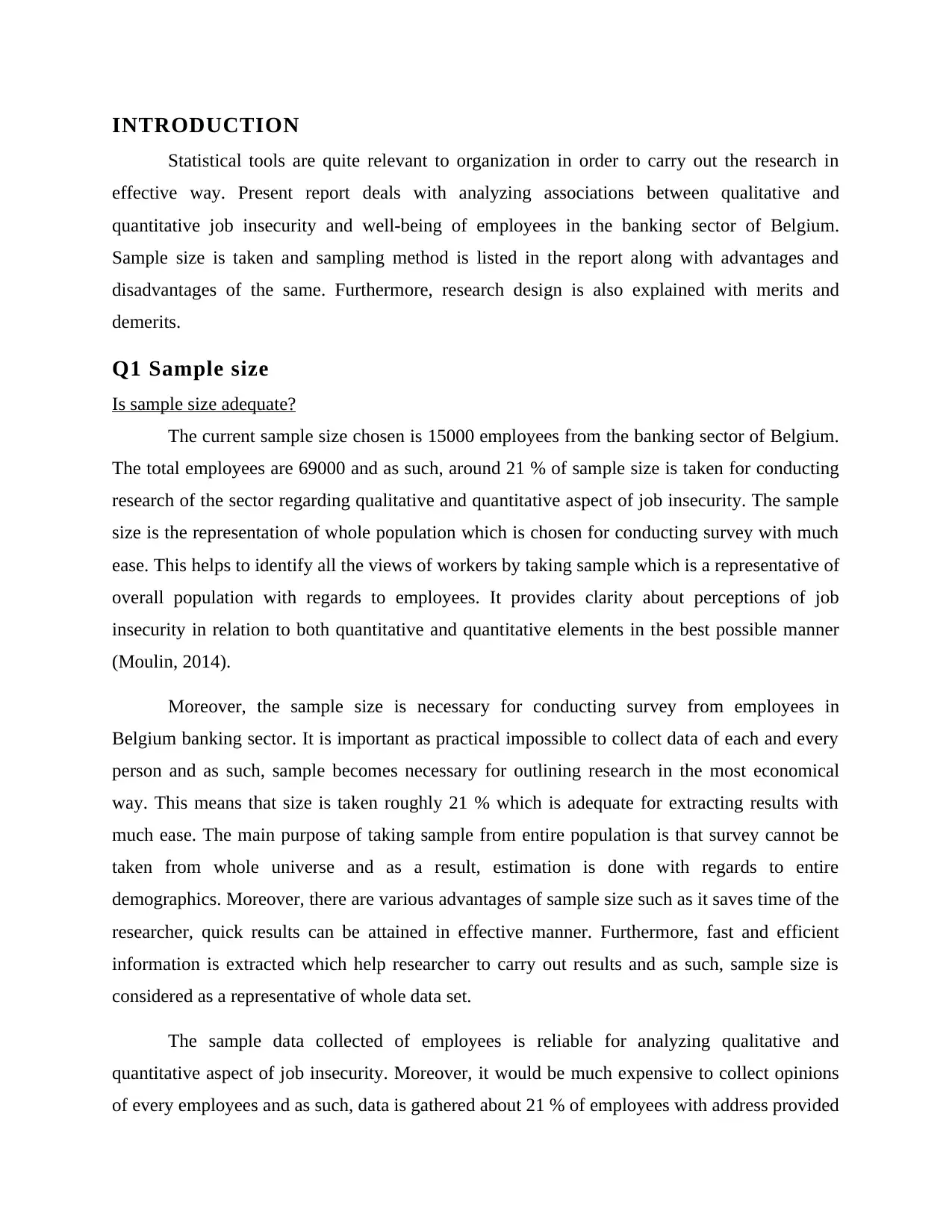
INTRODUCTION
Statistical tools are quite relevant to organization in order to carry out the research in
effective way. Present report deals with analyzing associations between qualitative and
quantitative job insecurity and well-being of employees in the banking sector of Belgium.
Sample size is taken and sampling method is listed in the report along with advantages and
disadvantages of the same. Furthermore, research design is also explained with merits and
demerits.
Q1 Sample size
Is sample size adequate?
The current sample size chosen is 15000 employees from the banking sector of Belgium.
The total employees are 69000 and as such, around 21 % of sample size is taken for conducting
research of the sector regarding qualitative and quantitative aspect of job insecurity. The sample
size is the representation of whole population which is chosen for conducting survey with much
ease. This helps to identify all the views of workers by taking sample which is a representative of
overall population with regards to employees. It provides clarity about perceptions of job
insecurity in relation to both quantitative and quantitative elements in the best possible manner
(Moulin, 2014).
Moreover, the sample size is necessary for conducting survey from employees in
Belgium banking sector. It is important as practical impossible to collect data of each and every
person and as such, sample becomes necessary for outlining research in the most economical
way. This means that size is taken roughly 21 % which is adequate for extracting results with
much ease. The main purpose of taking sample from entire population is that survey cannot be
taken from whole universe and as a result, estimation is done with regards to entire
demographics. Moreover, there are various advantages of sample size such as it saves time of the
researcher, quick results can be attained in effective manner. Furthermore, fast and efficient
information is extracted which help researcher to carry out results and as such, sample size is
considered as a representative of whole data set.
The sample data collected of employees is reliable for analyzing qualitative and
quantitative aspect of job insecurity. Moreover, it would be much expensive to collect opinions
of every employees and as such, data is gathered about 21 % of employees with address provided
Statistical tools are quite relevant to organization in order to carry out the research in
effective way. Present report deals with analyzing associations between qualitative and
quantitative job insecurity and well-being of employees in the banking sector of Belgium.
Sample size is taken and sampling method is listed in the report along with advantages and
disadvantages of the same. Furthermore, research design is also explained with merits and
demerits.
Q1 Sample size
Is sample size adequate?
The current sample size chosen is 15000 employees from the banking sector of Belgium.
The total employees are 69000 and as such, around 21 % of sample size is taken for conducting
research of the sector regarding qualitative and quantitative aspect of job insecurity. The sample
size is the representation of whole population which is chosen for conducting survey with much
ease. This helps to identify all the views of workers by taking sample which is a representative of
overall population with regards to employees. It provides clarity about perceptions of job
insecurity in relation to both quantitative and quantitative elements in the best possible manner
(Moulin, 2014).
Moreover, the sample size is necessary for conducting survey from employees in
Belgium banking sector. It is important as practical impossible to collect data of each and every
person and as such, sample becomes necessary for outlining research in the most economical
way. This means that size is taken roughly 21 % which is adequate for extracting results with
much ease. The main purpose of taking sample from entire population is that survey cannot be
taken from whole universe and as a result, estimation is done with regards to entire
demographics. Moreover, there are various advantages of sample size such as it saves time of the
researcher, quick results can be attained in effective manner. Furthermore, fast and efficient
information is extracted which help researcher to carry out results and as such, sample size is
considered as a representative of whole data set.
The sample data collected of employees is reliable for analyzing qualitative and
quantitative aspect of job insecurity. Moreover, it would be much expensive to collect opinions
of every employees and as such, data is gathered about 21 % of employees with address provided
⊘ This is a preview!⊘
Do you want full access?
Subscribe today to unlock all pages.

Trusted by 1+ million students worldwide
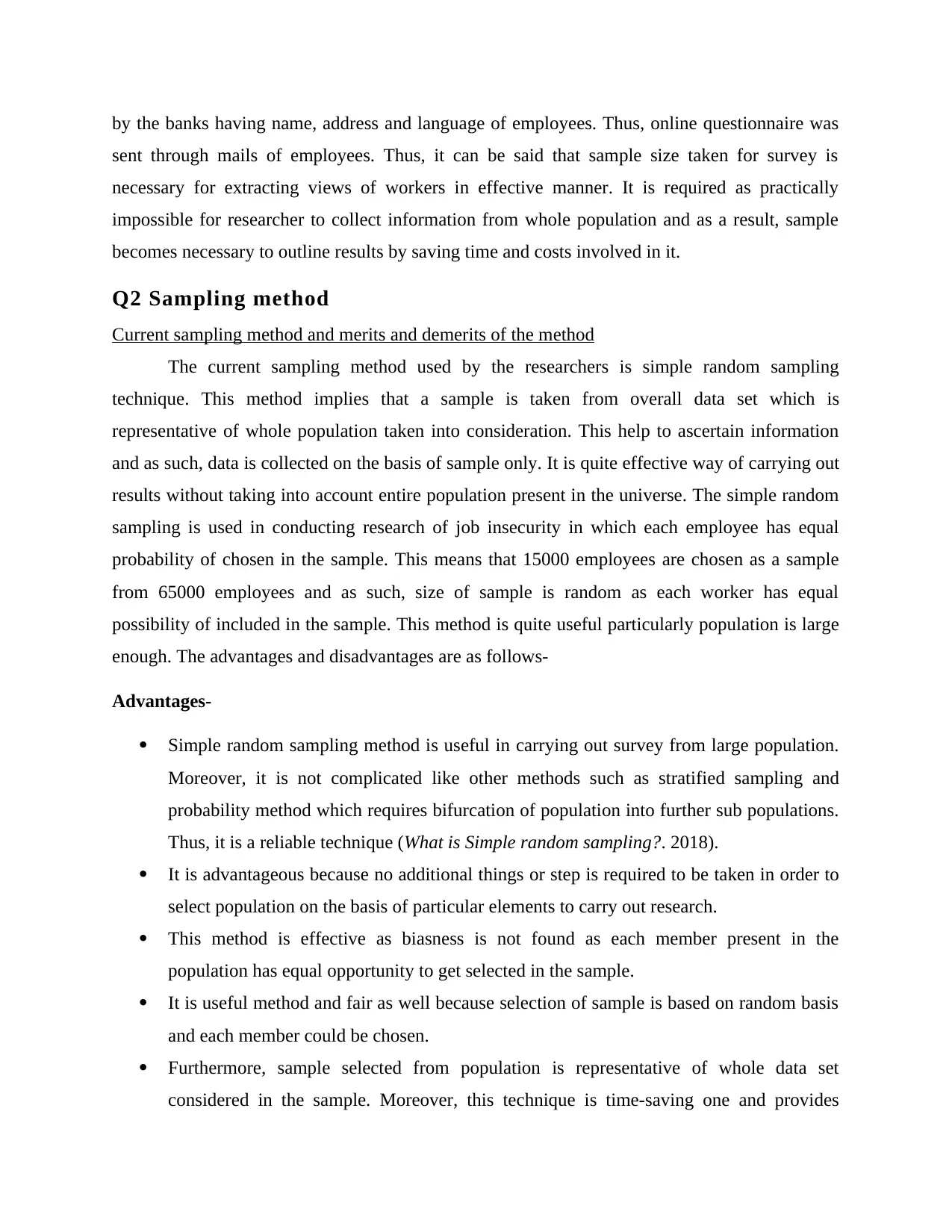
by the banks having name, address and language of employees. Thus, online questionnaire was
sent through mails of employees. Thus, it can be said that sample size taken for survey is
necessary for extracting views of workers in effective manner. It is required as practically
impossible for researcher to collect information from whole population and as a result, sample
becomes necessary to outline results by saving time and costs involved in it.
Q2 Sampling method
Current sampling method and merits and demerits of the method
The current sampling method used by the researchers is simple random sampling
technique. This method implies that a sample is taken from overall data set which is
representative of whole population taken into consideration. This help to ascertain information
and as such, data is collected on the basis of sample only. It is quite effective way of carrying out
results without taking into account entire population present in the universe. The simple random
sampling is used in conducting research of job insecurity in which each employee has equal
probability of chosen in the sample. This means that 15000 employees are chosen as a sample
from 65000 employees and as such, size of sample is random as each worker has equal
possibility of included in the sample. This method is quite useful particularly population is large
enough. The advantages and disadvantages are as follows-
Advantages-
Simple random sampling method is useful in carrying out survey from large population.
Moreover, it is not complicated like other methods such as stratified sampling and
probability method which requires bifurcation of population into further sub populations.
Thus, it is a reliable technique (What is Simple random sampling?. 2018).
It is advantageous because no additional things or step is required to be taken in order to
select population on the basis of particular elements to carry out research.
This method is effective as biasness is not found as each member present in the
population has equal opportunity to get selected in the sample.
It is useful method and fair as well because selection of sample is based on random basis
and each member could be chosen.
Furthermore, sample selected from population is representative of whole data set
considered in the sample. Moreover, this technique is time-saving one and provides
sent through mails of employees. Thus, it can be said that sample size taken for survey is
necessary for extracting views of workers in effective manner. It is required as practically
impossible for researcher to collect information from whole population and as a result, sample
becomes necessary to outline results by saving time and costs involved in it.
Q2 Sampling method
Current sampling method and merits and demerits of the method
The current sampling method used by the researchers is simple random sampling
technique. This method implies that a sample is taken from overall data set which is
representative of whole population taken into consideration. This help to ascertain information
and as such, data is collected on the basis of sample only. It is quite effective way of carrying out
results without taking into account entire population present in the universe. The simple random
sampling is used in conducting research of job insecurity in which each employee has equal
probability of chosen in the sample. This means that 15000 employees are chosen as a sample
from 65000 employees and as such, size of sample is random as each worker has equal
possibility of included in the sample. This method is quite useful particularly population is large
enough. The advantages and disadvantages are as follows-
Advantages-
Simple random sampling method is useful in carrying out survey from large population.
Moreover, it is not complicated like other methods such as stratified sampling and
probability method which requires bifurcation of population into further sub populations.
Thus, it is a reliable technique (What is Simple random sampling?. 2018).
It is advantageous because no additional things or step is required to be taken in order to
select population on the basis of particular elements to carry out research.
This method is effective as biasness is not found as each member present in the
population has equal opportunity to get selected in the sample.
It is useful method and fair as well because selection of sample is based on random basis
and each member could be chosen.
Furthermore, sample selected from population is representative of whole data set
considered in the sample. Moreover, this technique is time-saving one and provides
Paraphrase This Document
Need a fresh take? Get an instant paraphrase of this document with our AI Paraphraser
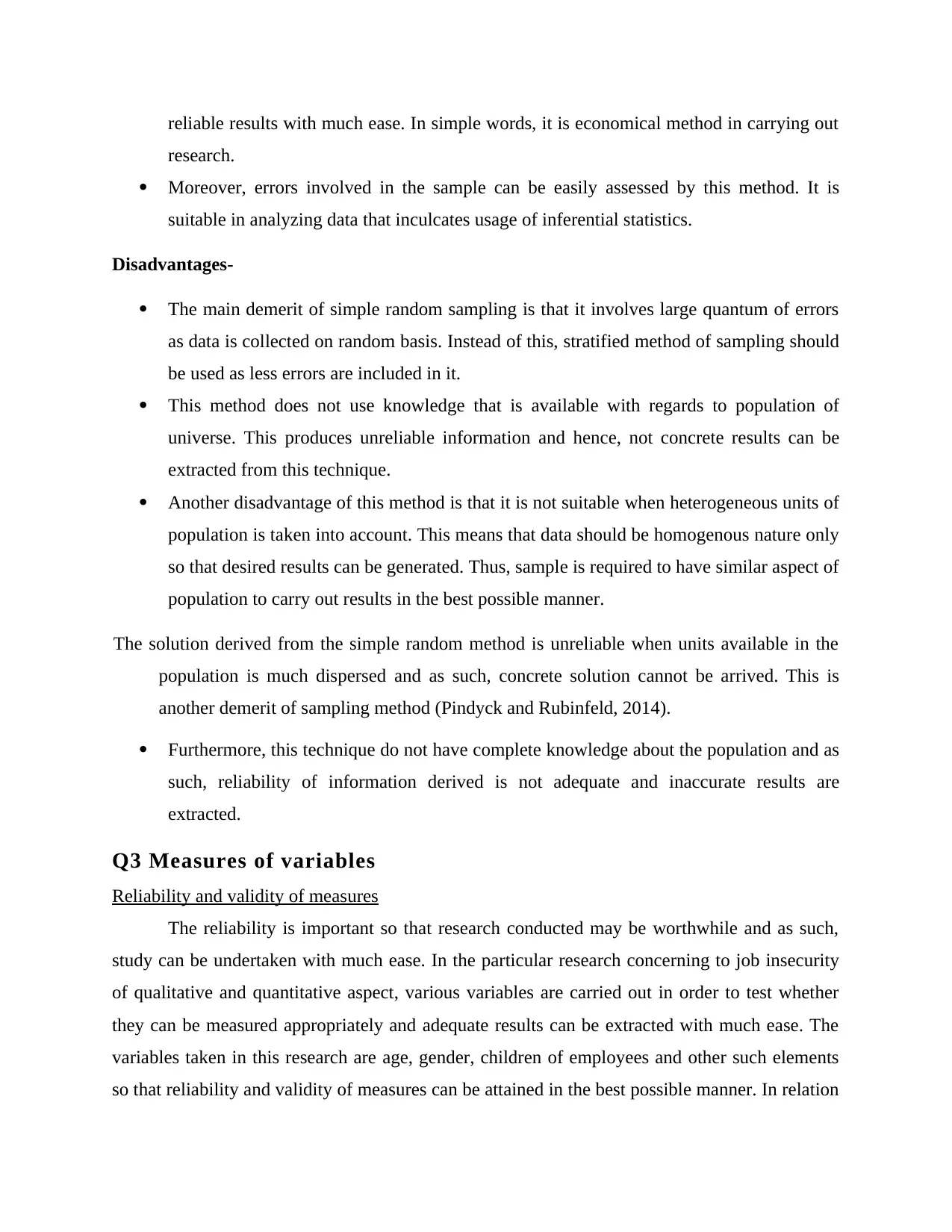
reliable results with much ease. In simple words, it is economical method in carrying out
research.
Moreover, errors involved in the sample can be easily assessed by this method. It is
suitable in analyzing data that inculcates usage of inferential statistics.
Disadvantages-
The main demerit of simple random sampling is that it involves large quantum of errors
as data is collected on random basis. Instead of this, stratified method of sampling should
be used as less errors are included in it.
This method does not use knowledge that is available with regards to population of
universe. This produces unreliable information and hence, not concrete results can be
extracted from this technique.
Another disadvantage of this method is that it is not suitable when heterogeneous units of
population is taken into account. This means that data should be homogenous nature only
so that desired results can be generated. Thus, sample is required to have similar aspect of
population to carry out results in the best possible manner.
The solution derived from the simple random method is unreliable when units available in the
population is much dispersed and as such, concrete solution cannot be arrived. This is
another demerit of sampling method (Pindyck and Rubinfeld, 2014).
Furthermore, this technique do not have complete knowledge about the population and as
such, reliability of information derived is not adequate and inaccurate results are
extracted.
Q3 Measures of variables
Reliability and validity of measures
The reliability is important so that research conducted may be worthwhile and as such,
study can be undertaken with much ease. In the particular research concerning to job insecurity
of qualitative and quantitative aspect, various variables are carried out in order to test whether
they can be measured appropriately and adequate results can be extracted with much ease. The
variables taken in this research are age, gender, children of employees and other such elements
so that reliability and validity of measures can be attained in the best possible manner. In relation
research.
Moreover, errors involved in the sample can be easily assessed by this method. It is
suitable in analyzing data that inculcates usage of inferential statistics.
Disadvantages-
The main demerit of simple random sampling is that it involves large quantum of errors
as data is collected on random basis. Instead of this, stratified method of sampling should
be used as less errors are included in it.
This method does not use knowledge that is available with regards to population of
universe. This produces unreliable information and hence, not concrete results can be
extracted from this technique.
Another disadvantage of this method is that it is not suitable when heterogeneous units of
population is taken into account. This means that data should be homogenous nature only
so that desired results can be generated. Thus, sample is required to have similar aspect of
population to carry out results in the best possible manner.
The solution derived from the simple random method is unreliable when units available in the
population is much dispersed and as such, concrete solution cannot be arrived. This is
another demerit of sampling method (Pindyck and Rubinfeld, 2014).
Furthermore, this technique do not have complete knowledge about the population and as
such, reliability of information derived is not adequate and inaccurate results are
extracted.
Q3 Measures of variables
Reliability and validity of measures
The reliability is important so that research conducted may be worthwhile and as such,
study can be undertaken with much ease. In the particular research concerning to job insecurity
of qualitative and quantitative aspect, various variables are carried out in order to test whether
they can be measured appropriately and adequate results can be extracted with much ease. The
variables taken in this research are age, gender, children of employees and other such elements
so that reliability and validity of measures can be attained in the best possible manner. In relation
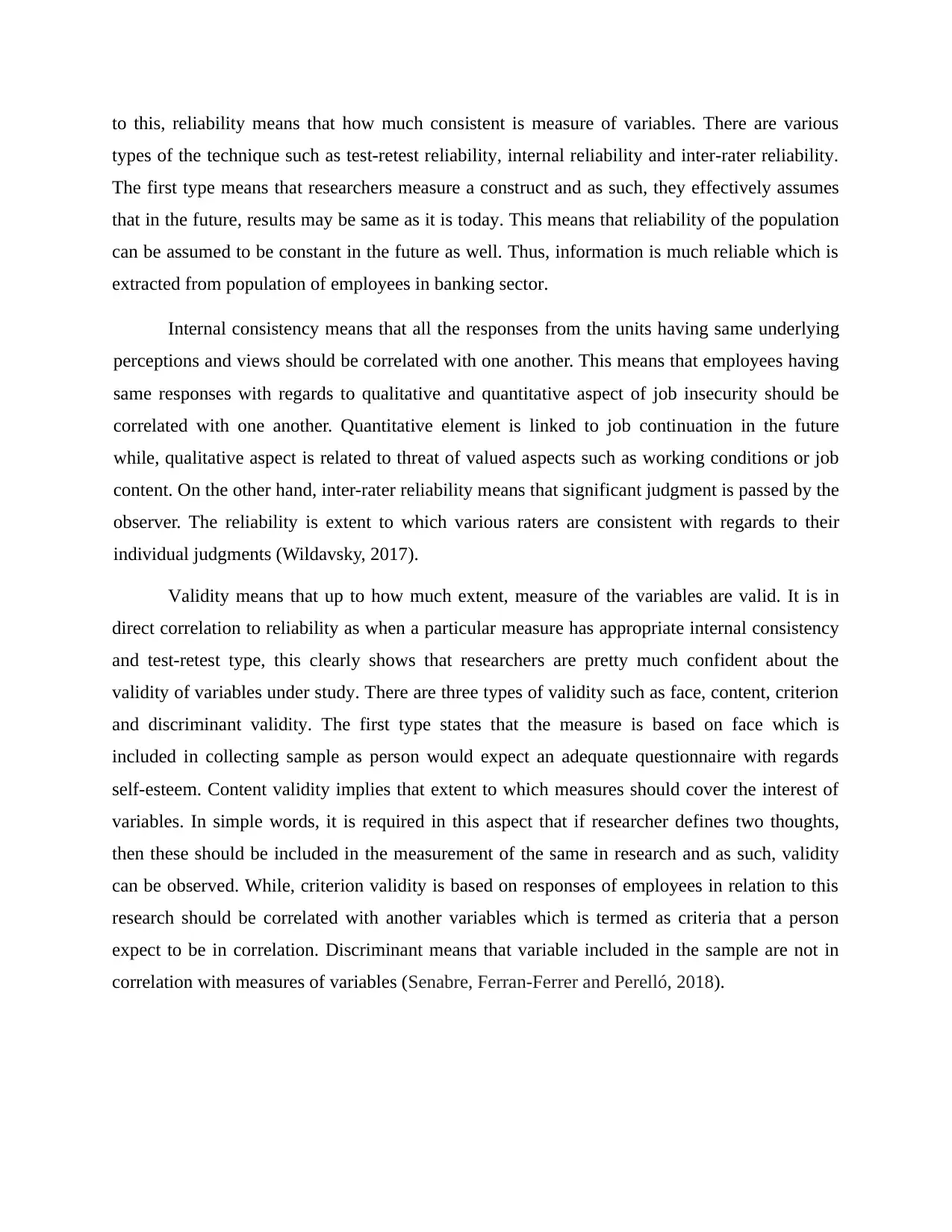
to this, reliability means that how much consistent is measure of variables. There are various
types of the technique such as test-retest reliability, internal reliability and inter-rater reliability.
The first type means that researchers measure a construct and as such, they effectively assumes
that in the future, results may be same as it is today. This means that reliability of the population
can be assumed to be constant in the future as well. Thus, information is much reliable which is
extracted from population of employees in banking sector.
Internal consistency means that all the responses from the units having same underlying
perceptions and views should be correlated with one another. This means that employees having
same responses with regards to qualitative and quantitative aspect of job insecurity should be
correlated with one another. Quantitative element is linked to job continuation in the future
while, qualitative aspect is related to threat of valued aspects such as working conditions or job
content. On the other hand, inter-rater reliability means that significant judgment is passed by the
observer. The reliability is extent to which various raters are consistent with regards to their
individual judgments (Wildavsky, 2017).
Validity means that up to how much extent, measure of the variables are valid. It is in
direct correlation to reliability as when a particular measure has appropriate internal consistency
and test-retest type, this clearly shows that researchers are pretty much confident about the
validity of variables under study. There are three types of validity such as face, content, criterion
and discriminant validity. The first type states that the measure is based on face which is
included in collecting sample as person would expect an adequate questionnaire with regards
self-esteem. Content validity implies that extent to which measures should cover the interest of
variables. In simple words, it is required in this aspect that if researcher defines two thoughts,
then these should be included in the measurement of the same in research and as such, validity
can be observed. While, criterion validity is based on responses of employees in relation to this
research should be correlated with another variables which is termed as criteria that a person
expect to be in correlation. Discriminant means that variable included in the sample are not in
correlation with measures of variables (Senabre, Ferran-Ferrer and Perelló, 2018).
types of the technique such as test-retest reliability, internal reliability and inter-rater reliability.
The first type means that researchers measure a construct and as such, they effectively assumes
that in the future, results may be same as it is today. This means that reliability of the population
can be assumed to be constant in the future as well. Thus, information is much reliable which is
extracted from population of employees in banking sector.
Internal consistency means that all the responses from the units having same underlying
perceptions and views should be correlated with one another. This means that employees having
same responses with regards to qualitative and quantitative aspect of job insecurity should be
correlated with one another. Quantitative element is linked to job continuation in the future
while, qualitative aspect is related to threat of valued aspects such as working conditions or job
content. On the other hand, inter-rater reliability means that significant judgment is passed by the
observer. The reliability is extent to which various raters are consistent with regards to their
individual judgments (Wildavsky, 2017).
Validity means that up to how much extent, measure of the variables are valid. It is in
direct correlation to reliability as when a particular measure has appropriate internal consistency
and test-retest type, this clearly shows that researchers are pretty much confident about the
validity of variables under study. There are three types of validity such as face, content, criterion
and discriminant validity. The first type states that the measure is based on face which is
included in collecting sample as person would expect an adequate questionnaire with regards
self-esteem. Content validity implies that extent to which measures should cover the interest of
variables. In simple words, it is required in this aspect that if researcher defines two thoughts,
then these should be included in the measurement of the same in research and as such, validity
can be observed. While, criterion validity is based on responses of employees in relation to this
research should be correlated with another variables which is termed as criteria that a person
expect to be in correlation. Discriminant means that variable included in the sample are not in
correlation with measures of variables (Senabre, Ferran-Ferrer and Perelló, 2018).
⊘ This is a preview!⊘
Do you want full access?
Subscribe today to unlock all pages.

Trusted by 1+ million students worldwide
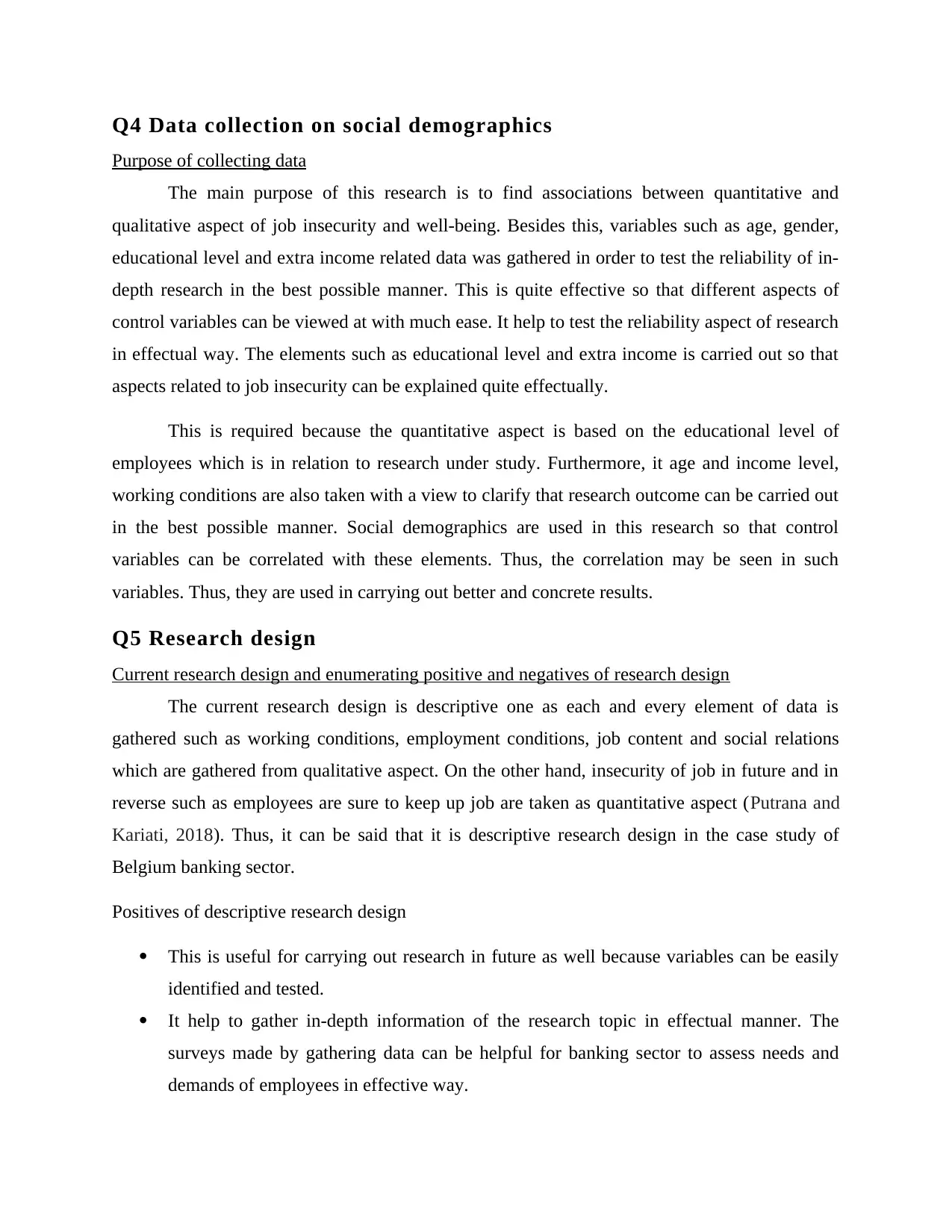
Q4 Data collection on social demographics
Purpose of collecting data
The main purpose of this research is to find associations between quantitative and
qualitative aspect of job insecurity and well-being. Besides this, variables such as age, gender,
educational level and extra income related data was gathered in order to test the reliability of in-
depth research in the best possible manner. This is quite effective so that different aspects of
control variables can be viewed at with much ease. It help to test the reliability aspect of research
in effectual way. The elements such as educational level and extra income is carried out so that
aspects related to job insecurity can be explained quite effectually.
This is required because the quantitative aspect is based on the educational level of
employees which is in relation to research under study. Furthermore, it age and income level,
working conditions are also taken with a view to clarify that research outcome can be carried out
in the best possible manner. Social demographics are used in this research so that control
variables can be correlated with these elements. Thus, the correlation may be seen in such
variables. Thus, they are used in carrying out better and concrete results.
Q5 Research design
Current research design and enumerating positive and negatives of research design
The current research design is descriptive one as each and every element of data is
gathered such as working conditions, employment conditions, job content and social relations
which are gathered from qualitative aspect. On the other hand, insecurity of job in future and in
reverse such as employees are sure to keep up job are taken as quantitative aspect (Putrana and
Kariati, 2018). Thus, it can be said that it is descriptive research design in the case study of
Belgium banking sector.
Positives of descriptive research design
This is useful for carrying out research in future as well because variables can be easily
identified and tested.
It help to gather in-depth information of the research topic in effectual manner. The
surveys made by gathering data can be helpful for banking sector to assess needs and
demands of employees in effective way.
Purpose of collecting data
The main purpose of this research is to find associations between quantitative and
qualitative aspect of job insecurity and well-being. Besides this, variables such as age, gender,
educational level and extra income related data was gathered in order to test the reliability of in-
depth research in the best possible manner. This is quite effective so that different aspects of
control variables can be viewed at with much ease. It help to test the reliability aspect of research
in effectual way. The elements such as educational level and extra income is carried out so that
aspects related to job insecurity can be explained quite effectually.
This is required because the quantitative aspect is based on the educational level of
employees which is in relation to research under study. Furthermore, it age and income level,
working conditions are also taken with a view to clarify that research outcome can be carried out
in the best possible manner. Social demographics are used in this research so that control
variables can be correlated with these elements. Thus, the correlation may be seen in such
variables. Thus, they are used in carrying out better and concrete results.
Q5 Research design
Current research design and enumerating positive and negatives of research design
The current research design is descriptive one as each and every element of data is
gathered such as working conditions, employment conditions, job content and social relations
which are gathered from qualitative aspect. On the other hand, insecurity of job in future and in
reverse such as employees are sure to keep up job are taken as quantitative aspect (Putrana and
Kariati, 2018). Thus, it can be said that it is descriptive research design in the case study of
Belgium banking sector.
Positives of descriptive research design
This is useful for carrying out research in future as well because variables can be easily
identified and tested.
It help to gather in-depth information of the research topic in effectual manner. The
surveys made by gathering data can be helpful for banking sector to assess needs and
demands of employees in effective way.
Paraphrase This Document
Need a fresh take? Get an instant paraphrase of this document with our AI Paraphraser
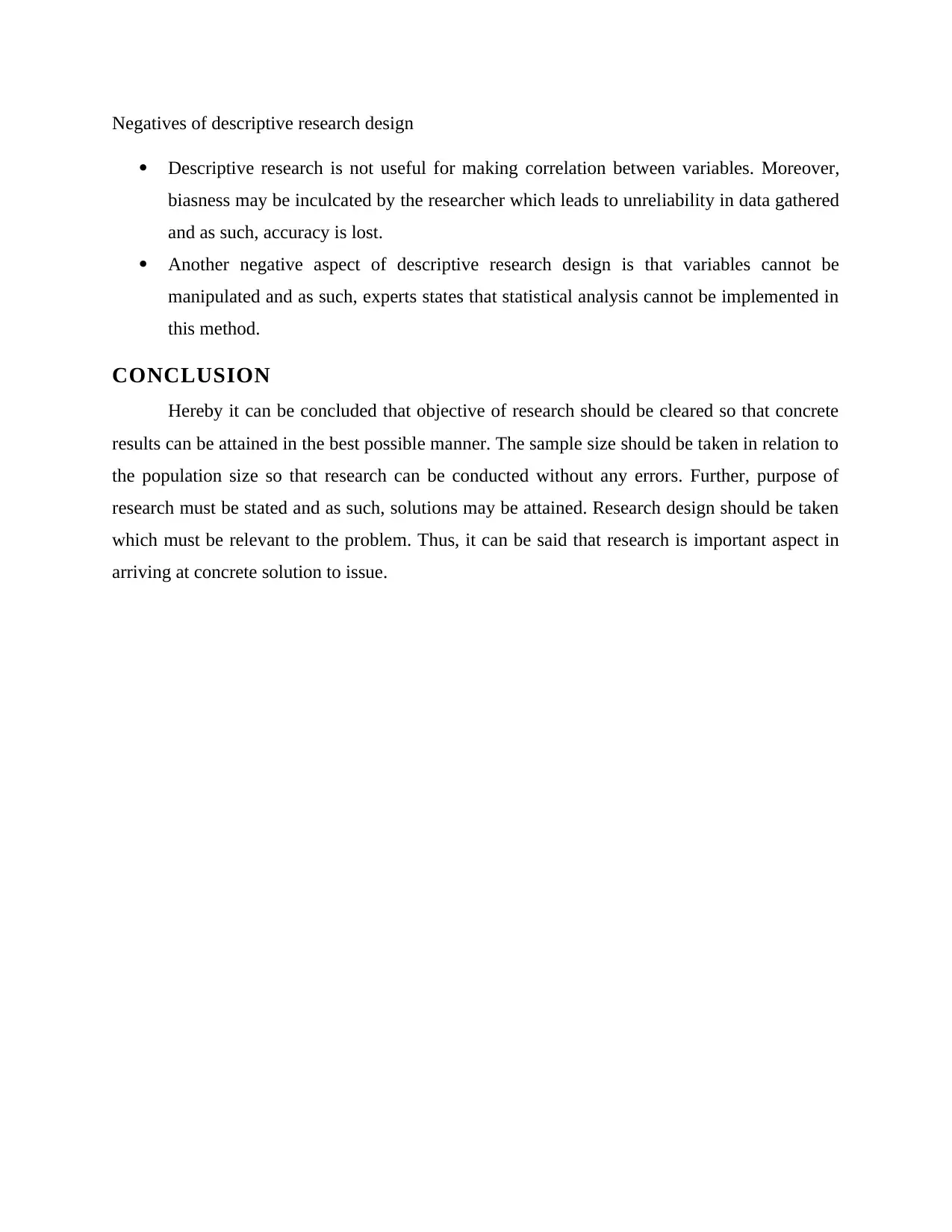
Negatives of descriptive research design
Descriptive research is not useful for making correlation between variables. Moreover,
biasness may be inculcated by the researcher which leads to unreliability in data gathered
and as such, accuracy is lost.
Another negative aspect of descriptive research design is that variables cannot be
manipulated and as such, experts states that statistical analysis cannot be implemented in
this method.
CONCLUSION
Hereby it can be concluded that objective of research should be cleared so that concrete
results can be attained in the best possible manner. The sample size should be taken in relation to
the population size so that research can be conducted without any errors. Further, purpose of
research must be stated and as such, solutions may be attained. Research design should be taken
which must be relevant to the problem. Thus, it can be said that research is important aspect in
arriving at concrete solution to issue.
Descriptive research is not useful for making correlation between variables. Moreover,
biasness may be inculcated by the researcher which leads to unreliability in data gathered
and as such, accuracy is lost.
Another negative aspect of descriptive research design is that variables cannot be
manipulated and as such, experts states that statistical analysis cannot be implemented in
this method.
CONCLUSION
Hereby it can be concluded that objective of research should be cleared so that concrete
results can be attained in the best possible manner. The sample size should be taken in relation to
the population size so that research can be conducted without any errors. Further, purpose of
research must be stated and as such, solutions may be attained. Research design should be taken
which must be relevant to the problem. Thus, it can be said that research is important aspect in
arriving at concrete solution to issue.
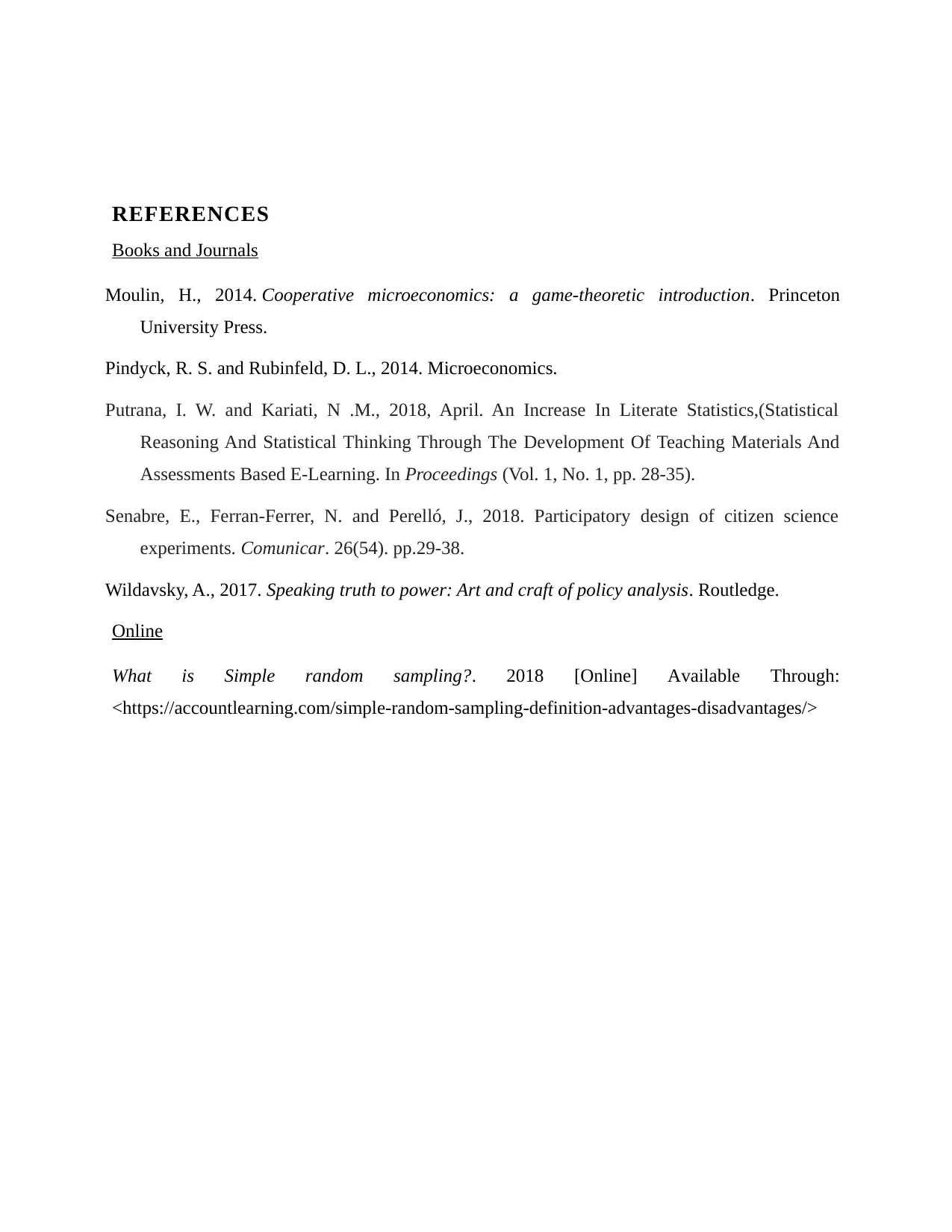
REFERENCES
Books and Journals
Moulin, H., 2014. Cooperative microeconomics: a game-theoretic introduction. Princeton
University Press.
Pindyck, R. S. and Rubinfeld, D. L., 2014. Microeconomics.
Putrana, I. W. and Kariati, N .M., 2018, April. An Increase In Literate Statistics,(Statistical
Reasoning And Statistical Thinking Through The Development Of Teaching Materials And
Assessments Based E-Learning. In Proceedings (Vol. 1, No. 1, pp. 28-35).
Senabre, E., Ferran-Ferrer, N. and Perelló, J., 2018. Participatory design of citizen science
experiments. Comunicar. 26(54). pp.29-38.
Wildavsky, A., 2017. Speaking truth to power: Art and craft of policy analysis. Routledge.
Online
What is Simple random sampling?. 2018 [Online] Available Through:
<https://accountlearning.com/simple-random-sampling-definition-advantages-disadvantages/>
Books and Journals
Moulin, H., 2014. Cooperative microeconomics: a game-theoretic introduction. Princeton
University Press.
Pindyck, R. S. and Rubinfeld, D. L., 2014. Microeconomics.
Putrana, I. W. and Kariati, N .M., 2018, April. An Increase In Literate Statistics,(Statistical
Reasoning And Statistical Thinking Through The Development Of Teaching Materials And
Assessments Based E-Learning. In Proceedings (Vol. 1, No. 1, pp. 28-35).
Senabre, E., Ferran-Ferrer, N. and Perelló, J., 2018. Participatory design of citizen science
experiments. Comunicar. 26(54). pp.29-38.
Wildavsky, A., 2017. Speaking truth to power: Art and craft of policy analysis. Routledge.
Online
What is Simple random sampling?. 2018 [Online] Available Through:
<https://accountlearning.com/simple-random-sampling-definition-advantages-disadvantages/>
⊘ This is a preview!⊘
Do you want full access?
Subscribe today to unlock all pages.

Trusted by 1+ million students worldwide

1 out of 10
Related Documents
Your All-in-One AI-Powered Toolkit for Academic Success.
+13062052269
info@desklib.com
Available 24*7 on WhatsApp / Email
![[object Object]](/_next/static/media/star-bottom.7253800d.svg)
Unlock your academic potential
Copyright © 2020–2025 A2Z Services. All Rights Reserved. Developed and managed by ZUCOL.





